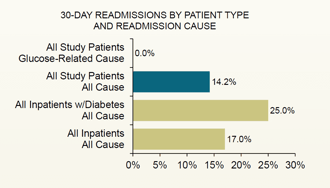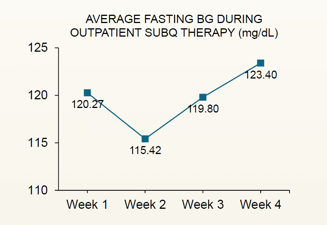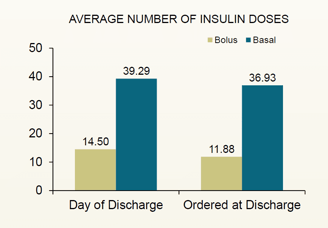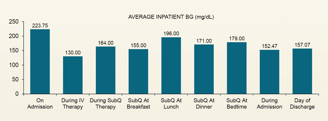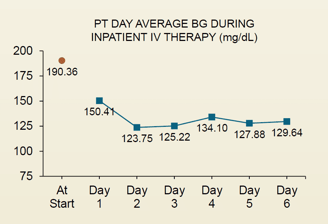Presentation
Annual Diabetes Technology Meeting
Date
November 2017
Authors
Jagdeesh Ullal, Raymie McFarland, H. Courtenay Harrison, Amy Bedingfield, Jessica Sheehan, Susan DeAbate, Christine Dignan, Rebecca Cwik, Genevieve Thompson, Paul Chidester
INTRODUCTION
This prospective quality improvement project evaluated the effectiveness an electronic glycemic management system (eGMS®) utilizing Glucommander™ and admission hemoglobin A1c (HbA1c) to transition patient to insulin therapy upon discharge using a Hospital-to-Home (H2H®) function.
PATIENT DEMOGRAPHICS
| Number of Patients | 28 |
|---|---|
| Length of Stay (days) | 9.25 |
| Age (yrs) | 57.43 |
| Sex – Male | 17 |
| Sex – Female | 11 |
| Height (in) | 66.52 |
| Weight (lb) | 215.37 |
| BMI | 33.55 |
| Race | 17 Caucasian, 11 African American |
| Reason for Admission | 24 Surgical, 4 Medical |
| A1C at Admission | 9.53% |
METHODS
After inpatient insulin titration by eGMS, providers used the H2H algorithm to determine insulin dosing prescribed at discharge. On discharge, patients checked blood glucose (BG) before each meal, at bedtime, and with perceived episodes of hypoglycemia. After discharge, we conducted four consecutive telephone interviews every seven days. The primary endpoint was safety of patients discharged using H2H to calculate basal or basal/bolus doses of insulin on day of discharge to home for patients with an HbA1c >6.5%. The aim was to reduce hypoglycemic events measured as mild (40-69 mg/dL) and severe (<40 mg/dL) as a primary safety measure. Secondary included change in fasting and mean daily blood glucose concentration, number of urgent care visits, emergency department visits and 30-day readmissions.
RESULTS
A total of 28 patients were enrolled. Average admission HbA1c was 9.5%, average admission BG was 223 mg/dL, average daily BG was 152 mg/dL and average discharge BG was 157 mg/dL. Telephone interviews revealed incidence of severe hypoglycemia <40 mg/dL was 3.6% (n=1 patient), mild hypoglycemia 40-69 mg/dL was 46% (n=13 patients), and hyperglycemia >300 mg/dL was 25% (n=7 patients). Average outpatient fasting BG was 119.72 mg/dL. Only one patient (3.6%) visited urgent care, 7.1% visited an emergency department and 14.2% were readmitted to the hospital within 30 days, all for reasons other than diabetes.
CONCLUSION
eGMS is a useful tool for providers to use at the time of discharge to determine home insulin dosing and titration. There was reasonable BG control post-discharge. Incidence of severe hypoglycemia was minimal and there were no urgent care visits, emergency department visits or hospital readmissions within 30 days of discharge due to diabetes or glucose-related causes.
